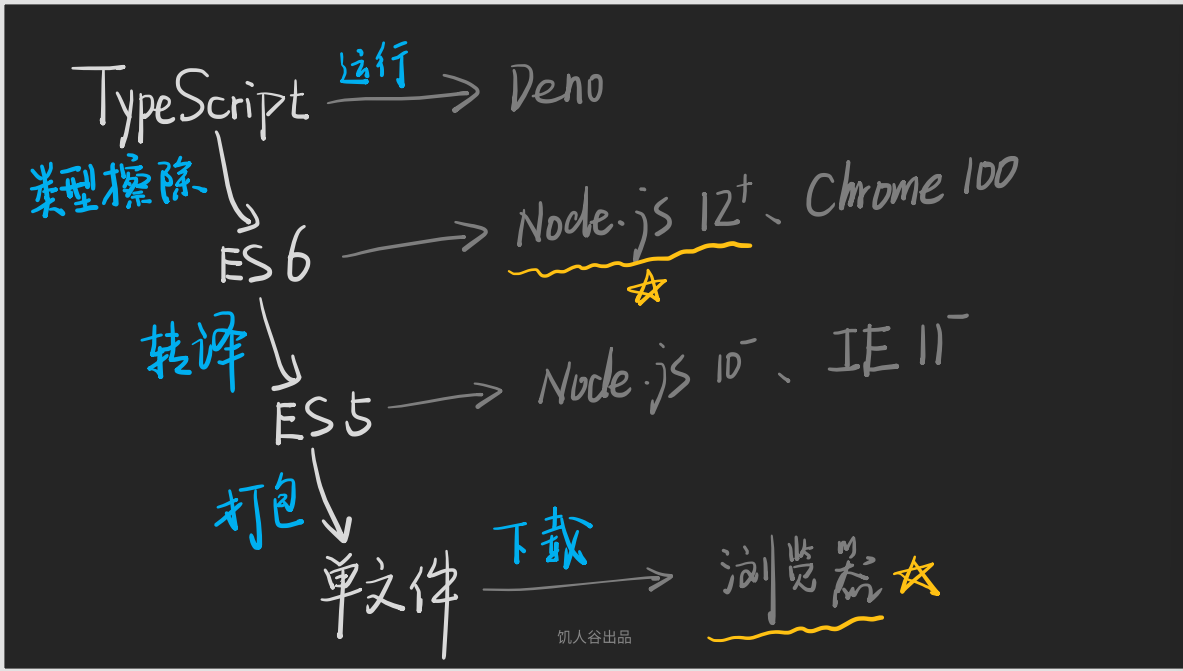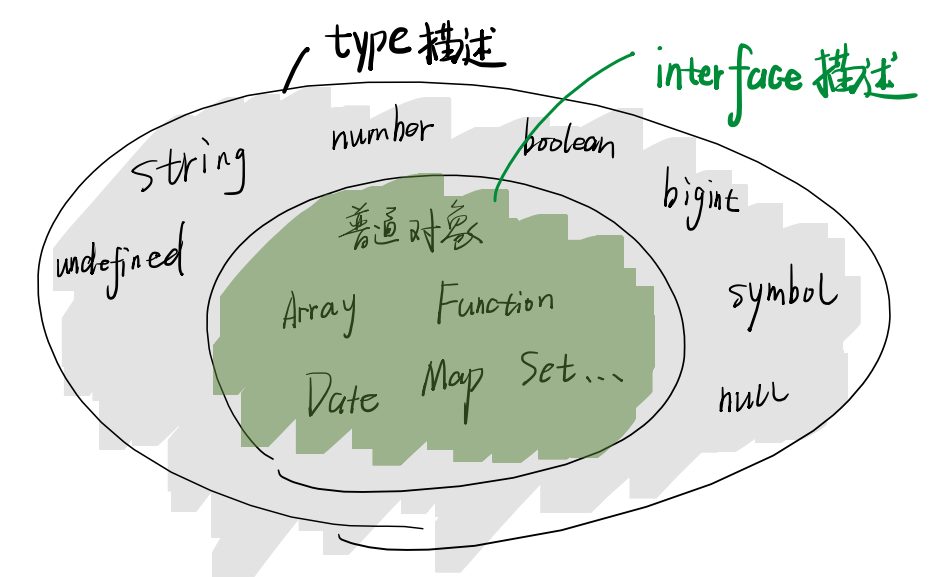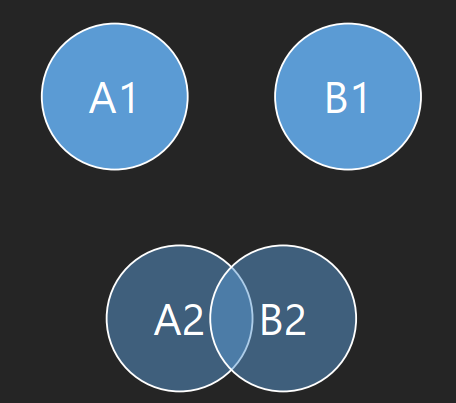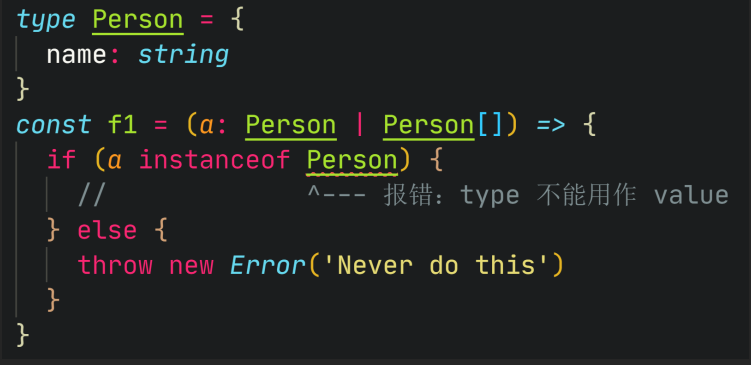# typescript 知识点
# ts 如何运行
一段 js 代码可以直接运行在浏览器/nodejs 环境中, 但是 ts 需要进行类型擦除才可以运行在浏览器/nodejs,否则会直接报错。 但可以通过 deno 直接运行。
如果需要擦除类型,可以使用的包包含:
- esbuild (快,不检查 ts 语法)
npm i -g esbuild - swc (快,不检查 ts 语法)
npm i -g @swc/cli @swc/core - tsc (慢, 会检查语法)
npm i -g typescript - babel (慢, 会检查语法, 依赖多,需要在项目中运行)
npm i @babel/core @babel/cli @babel/preset-typescript
- esbuild (快,不检查 ts 语法)
# 类型擦除
简单来讲就是 ts 经过类型擦除可以转化成 ES6 代码

# 数据类型
# JS / TS 类型
# JS
- null / undefined / string / number / boolean / object / Symbol / bigint
# ts
- 以上所有, 加上
- void / never / enum / unknown / any
- 再加上自定义类型 type / interface
# 为什么有两个 number/Number | string/String | boolean/Boolean 呢?
- 因为被 js 做了一层包装对象
42.toFixed(2)等价于let temp = new Number; value = tem.toFixed(2); delete temp return value;1
2
3
4- 所以 JS 中的 Number String Boolean 只用于包装对象
- 正常情况下 js/ts 都不用
# Object 类型
正常不会直接使用 object 类型在 ts
对象 = 普通对象
- 数组对象 Array
- 函数对象 Function
- 正则对象 RegExp
- 日期对象 Date
# 如何在 ts 中描述对象数据类型?
- 用 class 或者 constructor 描述
- 使用 type 或者 interface 描述
//索引签名
//k可以为任意
type A = {
[k: string]: string;
};
//等于泛型
type A2 = Record<string, number>;
2
3
4
5
6
7
- 结论: ts 一般使用索引签名或者
Record泛型来描述普通对象
# 数组对象
type A = string[];
//等价于
type AA = Array<string>
2
3
4
- 结论: ts 一般使用
Array<?>或者string[]或者[string, number]来描述数组
# 函数对象
type fnA = (a: number, b: number) => number;
- 结论: ts 一般使用
() => ?来描述函数
# any/unknown/never
- any 全知全能
- unknown 适合值从外部获取,不确定类型时候使用。 尽量使用这个然后自己去断言
- never 空集合不包含任何类型
# enum 枚举类型
# 应用场景 1 数字情况
// 什么时候用enum
// 数字 初始值为0
enum A {
todo,
done,
archived,
deleted,
}
2
3
4
5
6
7
8
9
# 应用场景 2 前端权限管理
enum Permission {
None = 0, // 0000
Read = 1 << 0, // 0001
Write = 1 << 1, // 0010
Delete = 1 << 2, // 0100
Manage = Read | Write | Delete, // 0111
}
type User = {
permission: Permission;
};
//0b开头证明这是二进制在js中
const user: User = {
permission: 0b0010,
};
// 任何一个x 与 Permission.Write 进行与操作(&) 结果等于Permission.Write, 那证明权限拥有
// 因为 与&预算, 都是1才为1
if ((user.permission & Permission.Write) === Permission.Write) {
console.log("user has right to write");
}
2
3
4
5
6
7
8
9
10
11
12
13
14
15
16
17
18
19
20
21
22
# 什么时候不用 enum
- 使用 string | other 类型时, 不用 enum
- 原因是可以使用更为简单直接的写法, 可直接提示赋值
# type
- 类型别名 Type Aliases
- 给其他类型取个名字(并没有产生真的人)
- 几乎什么时候都可以用
- type 不可以重新赋值
type Name = string;
type FalseLike = " | 0 | false | null | undefined";
type Point = { a: number; b: number };
type Points = Point[];
type Line = [Point, Point];
type Circle = { center: Point; radisu: number };
type Fn = (a: number) => number;
type FnWithProp = {
//note: 对象中声明函数不能像上面用箭头函数,要用冒号
(a: number, b: number): number;
prop: string;
};
2
3
4
5
6
7
8
9
10
11
12
# interface
- 用来声明接口
- 描述对象的属性(declare the shapes of objects)
- interface 自动合并
interface Date {
[key: string]: string;
}
interface Point {
x: number;
y: number;
}
interface Points extends Array<Point> {}
interface Fn {
(x: number, y: number): number;
}
2
3
4
5
6
7
8
9
10
11

# type interface 区别
- 区别 1: interface 只描述对象 type 则描述所有数据
- 区别 2: type 只是别名, interface 是(真名)类型声明
- 区别 3: 对外 API 尽量用 interface, 方便拓展。 对内部 API 尽量用 type, 防止代码分散
# void
- 返回空, 但是编译不会报错, 如果想要使用返回值时报错
# 联合类型 (并集 | )
# 举例
type A1 = number;
type B1 = string;
type C1 = A1 | B1;
const c1: C1 = "42";
const c2: C1 = 12;
2
3
4
5
6
7
type A2 = { name: string };
type B2 = { age: number };
type C2 = A2 | B2;
const c11: C2 = {
name: "xxx",
age: 61,
};
2
3
4
5
6
7
8
9

# 如何使用联合类型?
假如接受一个联合类型,string | number 既不能当作 string 直接使用,或者 number 直接使用 那么怎么直接使用这个变量?
答案: 想办法区分出类型
# 类型收窄
# 方法 1: 使用 typeof
const f1 = (a: number | string) => {
// 注意,这里只有50%几率是number / string
// 所以不能直接使用其对应的方法, 只能使用number & string的共同方法
// 只能想办法区分开类型
//方法1:使用typeof
// 也叫做类型收窄
if (typeof a === "number") {
a.toFixed(2);
} else if (typeof a === "string") {
a.toLocaleLowerCase();
} else {
// 注意这里是never
// 不能对a进行任何操作
console.log(a);
}
};
2
3
4
5
6
7
8
9
10
11
12
13
14
15
16
17
可以得到的值包含: string / number / bigint / boolean / symbal / undefined / object / function
局限性:array / normal obj / date / null 都会得到 object
# 方法 2: 使用 instanceOf
const f2 = (a: Date | Date[]) => {
//方法2:使用instanceOf
if (a instanceof Date) {
a.getDate();
} else if (a instanceof Array) {
a.push(new Date());
} else {
// 注意这里是never
// 不能对a进行任何操作
console.log(a);
}
};
2
3
4
5
6
7
8
9
10
11
12
13
- 局限性:
- 不支持 string / number / boolean 等
- 不支持独有的 ts 类型

# 方法 3: 使用 in
type Person = {
name: string;
};
type Animal = {
age: number;
};
const f3 = (a: Person | Animal) => {
//方法3:使用in
if ("name" in a) {
a.name.charCodeAt(0);
} else if ("age" in a) {
a.age.toString();
} else {
// 注意这里是never
// 不能对a进行任何操作
console.log(a);
}
};
2
3
4
5
6
7
8
9
10
11
12
13
14
15
16
17
18
19
20
- 局限性:适用于部分对象
# 方法 4: 使用 js 中的判断类型的函数区分或者逻辑
- 比如 Array.isArray 等
# 类型谓词 is(区分类型的万全办法)
type Rect = {
width: number;
height: number;
};
type Circle = {
center: [number, number];
radius: number;
};
// 在你的代码中,isRect和isCircle被定义为箭头函数表达式,所以按照正常的规则,它们应该在使用之前进行定义。
// 然而,在这种情况下,由于它们被用作类型谓词(Type Predicate),TypeScript的类型系统会对其进行特殊处理。
// TypeScript允许在类型谓词的上下文中使用尚未声明的函数。
// 这是因为类型谓词的类型检查是基于形状和类型的,而不是基于具体的运行时行为。
// 所以,尽管在代码中它们被定义为箭头函数表达式,在类型检查期间,TypeScript将会将它们视为类型谓词并进行处理。
const f1 = (a: Rect | Circle) => {
if (isRect(a)) {
console.log(a);
} else {
console.log(a);
}
};
const isRect = (x: Rect | Circle): x is Rect => {
return "height" in x && "width" in x;
};
const isCircle = (x: Rect | Circle): x is Circle => {
return "center" in x && "radius" in x;
};
2
3
4
5
6
7
8
9
10
11
12
13
14
15
16
17
18
19
20
21
22
23
24
25
26
27
28
29
30
31
32
33
- 优点: 支持所有 ts 类型
- 缺点:麻烦
# 可辩别联合 Discriminated Unions
type Rect = {
kind: "rect";
width: number;
height: number;
};
type Circle = {
kind: "circle";
center: [number, number];
radius: number;
};
type Shape = Circle | Rect; // 这里Shape就是可辨别联合类型
const f2 = (shape: Shape) => {
if (shape.kind === "circle") {
console.log(shape); // Circle
} else {
console.log(shape); // Rect
}
};
2
3
4
5
6
7
8
9
10
11
12
13
14
15
16
17
18
19
20
21
22
优点: 让复杂类型的收窄,变成简单类型的对比
要求:T=A|B|C|D....
- 要求 A|B|C|D 有相同的属性(比如 kind)
- kind 的类型必须是简单类型
- 各类型中的 kind 可以区分(无交集)
- 这个 T 就可以成为可辩别联合类型
# 交叉类型 (交集 &)
# 举例
type A = string & number; // A 是never
type L = {
lefthand: string;
};
type R = {
righthand: string;
};
type C = L | R;
type D = L & R;
const d: D = {
// Property righthand is missing
lefthand: "x",
};
2
3
4
5
6
7
8
9
10
11
12
13
14
15
16
17
18
假如使用 type 有属性冲突,会被推断成 never, 不能赋值
假如使用 interface 有属性冲突,会直接报错
两个函数的交集, 得到一个参数的并集
# 结论:
- 交叉类型常用于有交集的类型 A 、B
- 注意理解
type a = {name : string }是一个 name 为 string 的对象 A 类型,意思是这个可以包含其他任何属性在对象中, 所以并不单单这一个对象会包含在其中 - 但是赋值/第一次声明的时候, ts 会做严格检查, 也就是说第一次声明不能有额外的值在对象中
# 类型兼容与赋值
# 为什么要兼容
- 类型往往无法一致
- 你有的 我都有, 则我能代替你
- y 有的, x 都有, 则 x 兼容 y
# 简单类型
type A = string | number
let a : A = 'hi'
2
# 普通对象兼容
type Person = {
name: string,
age:number
}
let user = {
name:"xxx",
age: 18,
id:1,
email:"xx"
}
let p: Person;
p = user
2
3
4
5
6
7
8
9
10
11
12
13
14
这里 user 兼容 Person, 所以直接赋值不报错, 即使作为参数也不会报错
# 复杂函数(函数包含参数和返回值)
# 参数个数不同,能兼容吗?
接收两个参数的函数 = 接受一个参数的函数 (这样是 ok 的, 反之报错)
# 参数类型不同,能兼容吗?
对参数要求少的可以赋值给对参数要求多的
# 返回值类型不同, 能兼容吗?
返回值属性少集合大 = 返回值属性多集合小
# 对象类型语法
type Person = {
name: string;
};
interface PersonInterface{
name: string;
}
2
3
4
5
6
7
8
# 索引签名
type Person2 = {
name: string;
age?: number;
};
2
3
4
5
# 映射类型(多用于泛型)
type Hash2 = {
[key in string]: unknown;
};
2
3
# ?表示可选
type Person2 = {
name: string;
age?: number;
};
2
3
4
5
# readonly 表示只读, 不能写
type Person2 = {
readonly id:number;
name: string;
age?: number;
};
2
3
4
5
6
# 函数类型语法
对象的语法全部适用于函数
# 声明函数及其类型
//第一种, 先写类型再赋值
type F1 = (a:number, b:number) => number
const f1: F1 = (a,b) => a + b
//第二种, 先实现箭头函数, 再获取类型
const f2= (a:number, b:number):number => a + b
type F2 = typeof f2
//第三种, 先实现普通函数, 再获取类型
function f3= (this:unknown, a:number, b:number):number{
return a + b
}
type F3 = typeof f3
//第四种, 先实现匿名函数, 再获取类型
const f4= function(this:unknown, a:number, b:number):number{
return a + b
}
type F4 = typeof f4
2
3
4
5
6
7
8
9
10
11
12
13
14
15
16
17
18
19
# 类型谓词
funtion isPerson(x: Person | Animal):x is Person{
return 'name' in x
}
2
3
# 可选参数
addEventListener 第三个参数
# 参数默认值
# 参数也可以是函数
# 返回值也是函数
函数柯里化(redux 的 connect)
# 泛型
- ts 泛型 -> 理解为 js 的函数
type F<A|B> = A|B // 前面为接收参数 后为返回结果
type Result = F<string, number> // 返回一个类型, 调用F函数
2
- 不确定接受的参数是什么, 在需要用的时候才知道, 传进来的时候才知道
# extends
- 读作包含于(一个集合小于等于某个集合)
type LikeString<T> = T extends string ? true : false;
type LikeNumber<T> = T extends number ? 1 : 2;
type LikePerson<T> = T extends Person ? 'yes' : 'no';
2
3
- 规则 1: 若泛型 T 为 never, 则表达式的值为 never
- 规则 2: 若泛型 T 为联合类型, 则分开计算
- 注意 仅仅对泛型有效
泛型中,我们可以使用 extends 关键字来约束传入的泛型参数必须符合要求。关于 extends,A extends B 意味着 A 是 B 的子类型,这里我们暂时只需要了解非常简单的判断逻辑,也就是说 A 比 B 的类型更精确,或者说更复杂。具体来说,可以分为以下几类。
- 更精确,如字面量类型是对应原始类型的子类型,即 'jian' extends string,599 extends number 成立。类似的,联合类型子集均为联合类型的子类型,即 1、 1 | 2 是 1 | 2 | 3 | 4 的子类型。
- 更复杂,如 { name: string } 是 {} 的子类型,因为在 {} 的基础上增加了额外的类型,基类与派生类(父类与子类)同理。
# keyof
- keyof 操作符接受一个对象类型作为参数,返回该对象属性名组成的字面量联合类型,其作用类似 JavaScript 中的 Object.keys
- 获取到所有 T 泛型的 key
type Person = {
name: string;
age: number;
};
type GetKeys<T> = keyof T;
type Result = GetKeys<Person> //name || age
2
3
4
5
6
7
8
# extends keyof
type GetKeyType<T, K extends keyof T> = T[K] // 如果不加会报错, 因为K不一定是T的key
type ResTwo = GetKeyType<Person, 'name'>
2
3
# T[number]
获取元组 T 中所有元素的联合类型,即取出元组中所有可能的值,我们可以使用 T[number] 的写法。
# 泛型约束与默认值
像函数可以声明一个参数的默认值一样,泛型同样有着默认值的设定,比如:
type Factory<T = boolean> = T | number | string;
泛型中,我们可以使用 extends 关键字来约束传入的泛型参数必须符合要求。关于 extends,A extends B 意味着 A 是 B 的子类型,这里我们暂时只需要了解非常简单的判断逻辑,也就是说 A 比 B 的类型更精确,或者说更复杂。具体来说,可以分为以下几类。
- 更精确,如字面量类型是对应原始类型的子类型,即 'jian' extends string,599 extends number 成立。类似的,联合类型子集均为联合类型的子类型,即 1、 1 | 2 是 1 | 2 | 3 | 4 的子类型。
- 更复杂,如 { name: string } 是 {} 的子类型,因为在 {} 的基础上增加了额外的类型,基类与派生类(父类与子类)同理。
还可以给默认值
type ResStatus<ResCode extends number = 10000> = ResCode extends 10000 | 10001 | 10002
? 'success'
: 'failure';
type Res4 = ResStatus; // "success"
2
3
4
5
6
# 对象类型中的泛型
由于泛型提供了对类型结构的复用能力,我们也经常在对象类型结构中使用泛型。最常见的一个例子应该还是响应类型结构的泛型处理:
interface IRes<TData = unknown> {
code: number;
error?: string;
data: TData;
}
2
3
4
5
# 函数中的泛型
假设我们有这么一个函数,它可以接受多个类型的参数并进行对应处理,比如:
- 对于字符串,返回部分截取;
- 对于数字,返回它的 n 倍;
- 对于对象,修改它的属性并返回。 这个时候,我们要如何对函数进行类型声明?是 any 大法好?
function handle(input: string): string
function handle(input: number): number
function handle(input: {}): {}
function handle(input: string | number | {}): string | number | {} { }
2
3
4
这个时候,我们就该请出泛型了:
function handle<T>(input: T): T {}
# 类型查询操作符
TypeScript 还新增了用于类型查询的 typeof ,即 Type Query Operator,这个 typeof 返回的是一个 TypeScript 类型:
const str = "jian";
const obj = { name: "jian" };
const nullVar = null;
const undefinedVar = undefined;
const func = (input: string) => {
return input.length > 10;
}
type Str = typeof str; // "jian"
type Obj = typeof obj; // { name: string; }
type Null = typeof nullVar; // null
type Undefined = typeof undefined; // undefined
type Func = typeof func; // (input: string) => boolean
2
3
4
5
6
7
8
9
10
11
12
13
14
15
16
# 基于 in 与 instanceof 的类型保护
in 操作符 并不是 TypeScript 中新增的概念,而是 JavaScript 中已有的部分,它可以通过 key in object 的方式来判断 key 是否存在于 object 或其原型链上(返回 true 说明存在)。 既然能起到区分作用,那么 TypeScript 中自然也可以用它来保护类型:
interface Foo {
foo: string;
fooOnly: boolean;
shared: number;
}
interface Bar {
bar: string;
barOnly: boolean;
shared: number;
}
function handle(input: Foo | Bar) {
if ('foo' in input) {
input.fooOnly;
} else {
input.barOnly;
}
}
2
3
4
5
6
7
8
9
10
11
12
13
14
15
16
17
18
19
除此之外,JavaScript 中还存在一个功能类似于 typeof 与 in 的操作符:instanceof,它判断的是原型级别的关系,如 foo instanceof Base 会沿着 foo 的原型链查找 Base.prototype 是否存在其上。当然,在 ES6 已经无处不在的今天,我们也可以简单地认为这是判断 foo 是否是 Base 类的实例。同样的,instanceof 也可以用来进行类型保护:
class FooBase {}
class BarBase {}
class Foo extends FooBase {
fooOnly() {}
}
class Bar extends BarBase {
barOnly() {}
}
function handle(input: Foo | Bar) {
if (input instanceof FooBase) {
input.fooOnly();
} else {
input.barOnly();
}
}
2
3
4
5
6
7
8
9
10
11
12
13
14
15
16
17
18
# Top Type
再往上,我们就到达了类型层级的顶端(是不是很快),这里只有 any 和 unknown 这两兄弟。any 与 unknown 是系统中设定为 Top Type 的两个类型,它们无视一切因果律,是类型世界的规则产物。因此, Object 类型自然会是 any 与 unknown 类型的子类型。
type Result22 = Object extends any ? 1 : 2; // 1
type Result23 = Object extends unknown ? 1 : 2; // 1
2
# 向下探索,直到万物虚无
向下地探索其实就简单多了,首先我们能确认一定有个 never 类型,因为它代表了“虚无”的类型,一个根本不存在的类型。对于这样的类型,它会是任何类型的子类型,当然也包括字面量类型:
type Result24 = never extends any ? 1 : 2; // 1
type Result25 = never extends unknown ? 1 : 2; // 1
type Result26 = never extends string ? 1 : 2; // 1
2
3
# infer 关键字
TypeScript 中支持通过 infer 关键字来在条件类型中提取类型的某一部分信息,比如上面我们要提取函数返回值类型的话,可以这么放:
type FunctionReturnType<T extends Func> = T extends (
...args: any[]
) => infer R
? R
: never;
2
3
4
5
6
看起来是新朋友,其实还是老伙计。上面的代码其实表达了,当传入的类型参数满足 T extends (...args: any[] ) => infer R 这样一个结构(不用管 infer R,当它是 any 就行),返回 infer R 位置的值,即 R。否则,返回 never。 infer,意为推断,如 infer R 中 R 就表示 待推断的类型。 infer 只能在条件类型中使用,因为我们实际上仍然需要类型结构是一致的,比如上例中类型信息需要是一个函数类型结构,我们才能提取出它的返回值类型。如果连函数类型都不是,那我只会给你一个 never 。 这里的类型结构当然并不局限于函数类型结构,还可以是数组:
type Swap<T extends any[]> = T extends [infer A, infer B] ? [B, A] : T;
type SwapResult1 = Swap<[1, 2]>; // 符合元组结构,首尾元素替换[2, 1]
type SwapResult2 = Swap<[1, 2, 3]>; // 不符合结构,没有发生替换,仍是 [1, 2, 3]
2
3
4
由于我们声明的结构是一个仅有两个元素的元组,因此三个元素的元组就被认为是不符合类型结构了。但我们可以使用 rest 操作符来处理任意长度的情况:
// 提取首尾两个
type ExtractStartAndEnd<T extends any[]> = T extends [
infer Start,
...any[],
infer End
]
? [Start, End]
: T;
// 调换首尾两个
type SwapStartAndEnd<T extends any[]> = T extends [
infer Start,
...infer Left,
infer End
]
? [End, ...Left, Start]
: T;
// 调换开头两个
type SwapFirstTwo<T extends any[]> = T extends [
infer Start1,
infer Start2,
...infer Left
]
? [Start2, Start1, ...Left]
: T;
2
3
4
5
6
7
8
9
10
11
12
13
14
15
16
17
18
19
20
21
22
23
24
25
26
是的,infer 甚至可以和 rest 操作符一样同时提取一组不定长的类型,而 ...any[] 的用法是否也让你直呼神奇?上面的输入输出仍然都是数组,而实际上我们完全可以进行结构层面的转换。比如从数组到联合类型:
type ArrayItemType<T> = T extends Array<infer ElementType> ? ElementType : never;
type ArrayItemTypeResult1 = ArrayItemType<[]>; // never
type ArrayItemTypeResult2 = ArrayItemType<string[]>; // string
type ArrayItemTypeResult3 = ArrayItemType<[string, number]>; // string | number
2
3
4
5
# 逆变与协变
// 逆变和协变 // 函数类型的参数类型使用子类型逆变的方式确定是否成立, // 返回值使用子类型协变的方式确定是否成立.